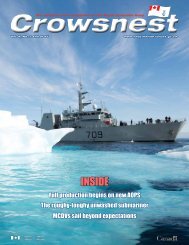Create successful ePaper yourself
Turn your PDF publications into a flip-book with our unique Google optimized e-Paper software.
ecently noted, “[e]conomic growth taking place in East <strong>and</strong> Sou<strong>the</strong>ast Asia has been one <strong>of</strong> <strong>the</strong><br />
most significant force-shaping changes in <strong>the</strong> contemporary commercial environment”. 187<br />
In this new constellation <strong>of</strong> <strong>Power</strong>s, <strong>the</strong> challenges facing <strong>the</strong> oceans as a global commons will be<br />
most pronounced in Asia in coming decades; <strong>and</strong> because <strong>of</strong> <strong>the</strong> shifting balance <strong>of</strong> power that<br />
means that <strong>the</strong>y will be highly relevant in <strong>the</strong>ir potential strategic impact. “[S]tarting in <strong>the</strong> last<br />
phase <strong>of</strong> <strong>the</strong> Cold War,” journalist Robert Kaplan has written, “<strong>the</strong> demographic, economic, <strong>and</strong><br />
military axis <strong>of</strong> <strong>the</strong> earth has measurably shifted to <strong>the</strong> opposite end <strong>of</strong> Eurasia, where <strong>the</strong> spaces<br />
between <strong>the</strong> principal nodes <strong>of</strong> population are overwhelmingly maritime.” 188 Newly affluent<br />
societies in Asia will dem<strong>and</strong> increased levels <strong>of</strong> consumer goods <strong>and</strong> will lead energy dependent<br />
lifestyles. It is expected that urbanisation will take place on a scale never seen before in low- to<br />
medium-income countries throughout <strong>the</strong> region, <strong>and</strong> this will need a vast range <strong>of</strong> materiel for<br />
construction <strong>of</strong> new city environments. 189 <strong>The</strong> increased requirement for food, energy, consumer<br />
goods <strong>and</strong> raw materials to build necessary social infrastructure will result in a growing dem<strong>and</strong><br />
for commercial shipping, including an expected growth in <strong>the</strong> number <strong>of</strong> large container ships<br />
transiting Asian waters. 190 Intra-regional trade, already comprising 53 percent <strong>of</strong> all Asian trade,<br />
is also likely to intensify, possibly leading to greater levels <strong>of</strong> political <strong>and</strong> economic integration,<br />
but certainly putting new strains on existing maritime trade routes. 191 But even more likely <strong>and</strong><br />
more unsettling is that national ambitions could become more pronounced as states <strong>and</strong> societies<br />
become wealthier <strong>and</strong> have greater resources to pursue new opportunities <strong>and</strong> objectives.<br />
Longst<strong>and</strong>ing animosities <strong>and</strong>/or rivalries could dangerously inflate clashing interests among<br />
increasingly affluent <strong>and</strong> self-confident regional governments.<br />
To comprehend <strong>the</strong> strategic implications <strong>of</strong> what is happening, economic developments cannot<br />
be considered in isolation from geography. <strong>The</strong> most distinguishing geostrategic features are <strong>the</strong><br />
predominance <strong>of</strong> waters <strong>and</strong> its immense size. Unlike Europe, that was <strong>the</strong> focus <strong>of</strong> Great <strong>Power</strong><br />
competition for much <strong>of</strong> <strong>the</strong> previous two centuries, geography poses a different type <strong>of</strong> challenge<br />
for South <strong>and</strong> East Asia for it involves many thous<strong>and</strong>s <strong>of</strong> miles. More telling still, a principal<br />
player in <strong>the</strong> region’s strategic affairs, <strong>the</strong> United States, looking across <strong>the</strong> Pacific, is located<br />
more than 6,000 miles away from <strong>the</strong> Asian mainl<strong>and</strong>. Equally important, <strong>the</strong> chain <strong>of</strong> isl<strong>and</strong>s that<br />
runs from Russia’s Kuriles to <strong>the</strong> sou<strong>the</strong>rn tip <strong>of</strong> New Zeal<strong>and</strong>, act as a barrier to incursion from<br />
<strong>the</strong> Western Pacific, but also <strong>of</strong>fer a means <strong>of</strong> controlling (or at <strong>the</strong> very least effectively<br />
monitoring) access to that ocean. 192 As a consequence, <strong>and</strong> unlike Europe, with <strong>the</strong> exception <strong>of</strong><br />
187 Rodrigue, <strong>The</strong> Geography <strong>of</strong> Transport Systems (3 rd ed), p. 19. <strong>The</strong> rise <strong>of</strong> <strong>the</strong> Asian economies is<br />
mirrored by <strong>the</strong> relative decline in those <strong>of</strong> <strong>the</strong> West. According to a February 2015 report prepared by<br />
Price Waterhouse Coopers, a global business consulting firm, <strong>the</strong> number <strong>of</strong> Western countries in a list <strong>of</strong><br />
<strong>the</strong> 10 largest national economies is expected to decline from four (<strong>the</strong> US, Germany, France <strong>and</strong> <strong>the</strong> UK)<br />
in 2014, to three (<strong>the</strong> US, Germany <strong>and</strong> <strong>the</strong> UK) in 2030, to two (<strong>the</strong> US <strong>and</strong> Germany) in 2050. Price<br />
Waterhouse Coopers, <strong>The</strong> World in 2050: Will <strong>the</strong> shift in global economic power continue? (February<br />
2015), [accessed on 5 March 2015 at http://monitor.icef.com/2015/03/global-economic-power-projectedshift-asia-emerging-economies-2050/]<br />
p. 4.<br />
188 Robert Kaplan, Asia’s Cauldron: <strong>The</strong> South China Sea <strong>and</strong> <strong>the</strong> End <strong>of</strong> a Stable Pacific (R<strong>and</strong>om House:<br />
New York, 2015).<br />
189 Lloyd’s Register Group et al., Global Marine Trends, 2030, p. 51.<br />
190 Lloyd’s Register Group et al., Global Marine Trends, 2030, p. 26.<br />
191 Jones, “Introduction” in Jones (ed.), A <strong>Maritime</strong> School <strong>of</strong> Strategic Thought for Australia, p. 5.<br />
192 Roy Kamphausen, “Asia as a Warfighting <strong>Environment</strong>”, in Thomas G. Mahnken <strong>and</strong> Dan Bluemthal (eds.),<br />
Strategy in Asia; <strong>The</strong> Past, Present <strong>and</strong> <strong>Future</strong> <strong>of</strong> Regional Security (Stanford University Press: 2014), pp. 16–19.<br />
DRDC-RDDC-2016-R085 39




